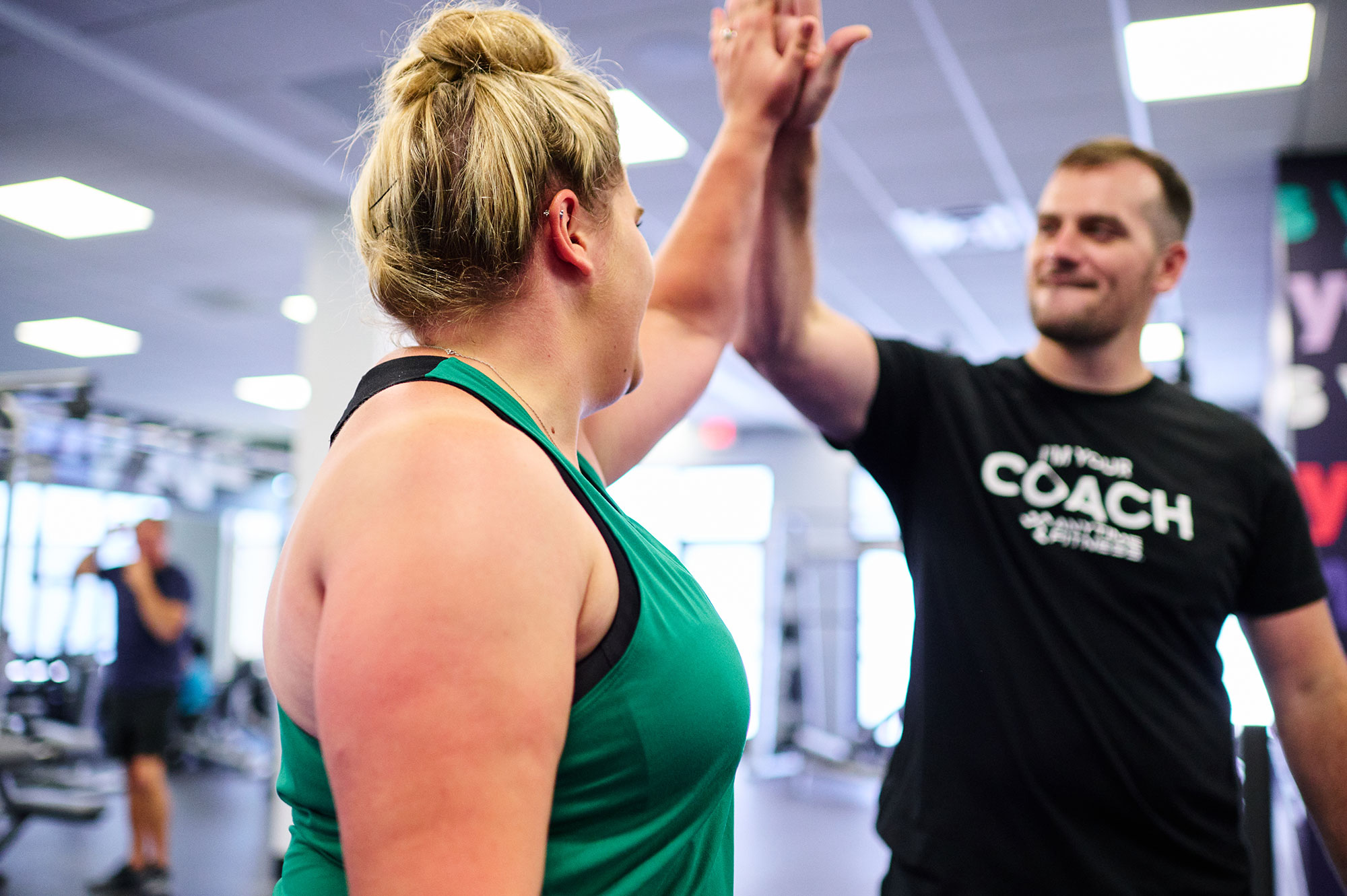Many of us approach our fitness or weight-loss goals with a sense of confidence and a simple plan: eat less and workout more. But as anyone who’s been on that journey can tell you, it’s just unsustainable. (Not to mention, “eating less” is both inaccurate and unrealistic.)
We aren’t here to tell you why your health journey will not work, however! We’re here to tell you that you’re not alone, and we’ve got a plan.
1. Create a sustainable plan of action
We all know the importance of focusing on activities and nutrition that are good for our mind and body. But let’s face it, it’s often easier said than done. In fact, sticking to habits can often be just as difficult as creating new ones in the first place.
Four steps to habit formation
The National Institutes of Health (NIH) recommends breaking habit formation into four stages in order to create and maintain healthy behaviors:
- Contemplation: Think about the changes you want to make, and start getting motivated! It can help to be specific (e.g. rather than having a goal to drink more water, resolve to drink two more glasses a day). Make a list of pros and cons that come with the desired change.
- Preparation: Once you decide on the new habits you want to form, you can start planning how to make changes. Look at the cons list from step 1; these are your roadblocks. Now’s the time to come up with possible solutions for overcoming these roadblocks as you begin to change your habits. Now let’s set some goals and make a plan! Start with small changes as the foundation for a healthier lifestyle. Going too big too fast can often lead to burnout before you’ve even really gotten started (see number 2 below).
- Action: This is when you enact changes and start your routine. As you begin, track your progress (see numbers 3 and 4). The goal here is to identify your strengths, find areas where you can improve, and stay on course. Record your actions, and also record how you felt while doing them. The emotional aspect can play a key role in making your new habits stick.
- Maintenance: Once you have kept up new habits for six months, you are in the maintenance stage. At this point, you should continue to track your progress. When you feel confident in how you’re maintaining your habits, you can start giving yourself rewards. And lastly, add some variety or challenge to your routine. Consider throwing in some new physical activities or recipe ideas. This will help keep things fun and interesting.
2. Remind yourself: It’s not a sprint
If you were to begin a marathon at full throttle, not only would you risk not making it to the finish line, but you might not even make it to mile two. A fitness journey is the same. All that early enthusiasm builds up, making anything seem possible. And it is possible! Possible, however, doesn’t equal quick and easy.
Like our man Ted said (Roosevelt, not Lasso): “Nothing in this world is worth having or worth doing unless it means effort, pain, difficulty. No kind of life is worth leading if it is always an easy life.” Is there anything more “worthy” of your time and effort than your health? Or anything more rewarding?
So, approach your goals with progress in mind. The results will come. As our man Ted said (no not Roosevelt, Lasso!): “Taking on a challenge is a lot like riding a horse, isn’t it? If you’re comfortable while you’re doing it, you’re probably doing it wrong.”
3. Drink as much water as you can

We’ve said it before, we’ll say it again: Drink water. Staying hydrated helps the body function at a basic level. But beyond that, it can be advantageous to fitness and weight-loss goals. Research shows that the more hydrated we are, the more efficiently our bodies work at tasks that range from thinking to burning body fat.
From a weight-loss standpoint, drinking plenty of water can help in small but important ways. Water may help naturally suppress your appetite, and it can stimulate the body’s metabolism.
Drinking water is also essential for effective exercise. When you drink water, it dissolves electrolytes and distributes them throughout the body. This is important because those electrolytes can now trigger muscle contractions that are required for working out. Without them, the muscles may start to cramp up. Plus, if your muscles are dehydrated, they break down protein (aka muscle) more quickly and build muscle more slowly, so your workouts are much less effective.
A few ideas for drinking more water throughout the day:
- Drink a glass of water each time you use the restroom.
- Get into the habit of leaving a glass by the kitchen sink and every time you pass it, drink a glass of water.
- Add some lemon, cucumber, mint, or basil to your water to level up the flavor.
- It might sound a bit silly, but what you drink out of can also influence your drinking habits. Find a water bottle with a texture that’s satisfying to your senses. Or, in the evening, try pouring some flavored water into a wine glass with a few berries. Adding a little bit of luxury can make it feel like a treat.
4. Stick to a grocery list
If you have a penchant for junk food and find yourself unable to eat it in moderation, then recognize that trait in yourself and do something about it (this goes back to overcoming your roadblocks). Make a list of groceries before you go to the store, and once you’re there, stick to it. Avoid the candy aisle altogether. And while it might be tempting to grab a bag of chips in the moment, you’ll likely lose that urge the minute you step out of the store. Muster up that self-control and stick to the list.
5. Know your nutrition, or find a tracking tool to help
Maybe part of the problem is that you don’t know how to define problem foods (outside of the obvious cookies and pizza). Investigative science professional and health journalist Gary Taubes might be able to help. In his book, Good Calories, Bad Calories, Taubes argues that calories themselves are not the villain. Instead, it’s what the calories are made of that can create the problem. For instance, broccoli and bagels are both primarily carbohydrates, but do very different things in the body. Eating the same number of calories from broccoli as from bagels would yield different results. That’s why it’s important to have a baseline knowledge of nutrition.

Another option would be to rely on a nutrition app or tracker. Eating too much or eating too little are equal enemies of maintaining weight loss and feeling healthy. It might seem counterintuitive that each end of the spectrum can get in the way of healthy habits, but eating too little can leave you feeling deprived, which can lead to gorging on unhealthy food. It can also result in less effective workouts. Therefore, one of the best ways to stand up to healthy portion saboteurs is to keep track of what you eat, at least at the start of your journey.
Important: The goal is not to become obsessed with what you eat. And it’s not about counting calories. The goal of tracking your eating habits is to learn what those habits are, as well as what healthy nutrition actually looks like. You can’t fix a problem if you don’t know it’s there, and seeing your daily menu on an app or in a journal page is a good place to start.
6. Keep a tangible calendar on the wall
Yes, it’s oldschool. But actively checking off your goals feeds the part of the brain that wants to feel accomplishment and keep motivation high. Whether it’s about getting enough physical activity or staying on top of meal planning, a calendar can help serve up daily reminders. Plus seeing those goals accomplished — coupled with feeling healthier and stronger as the days go on — stokes the flames of victory, creating a positive feedback loop that puts wind in your sails.
7. Establish an accountability buddy

It helps to know that someone else understands the struggle of maintaining a healthy diet and exercise plan. Having an appointed friend or Coach you can call or text in a moment of weakness can do wonders. Making yourself accountable to someone else (and vice versa) means that reaching your goal will result in you:
- Keeping a promise to yourself and your accountability partner
- Making someone else happy
- Strengthening relationships with those around you
In 2015, the American Society of Training and Development found that people are 65% more likely to meet a goal after committing to another person. Those chances go up to 95% when you plan for regular, ongoing progress check-ins.
8. Ask yourself: “Will I be happy with that decision in a couple of hours?”
Whether it’s about skipping a workout or indulging an unhealthy food craving, look past that moment and focus on the long term. Odds are, you’ll recognize that your future self will be grateful if you do in fact take that walk.
BUT. Whatever the choice is, it’s yours to make. So…
9. Drop the guilt
If you do decide in that moment to eat the ice cream treat, then make sure you enjoy it. When you’re finished, leave the guilt at the door. If you mentally punish yourself, the enjoyment is gone, and you’re giving power to the food. In turn, you’ll feel unsatisfied and will almost certainly do it again.
Similarly, don’t harangue yourself for skipping one workout. Instead, use that time to indulge in some other form of self-care. And even if later in the day you’re thinking, “yeah, I shouldn’t have skipped that yoga class this morning,” then take it as a lesson for next time. Don’t wallow in negativity.
10. Know how to get back on track
It’s common for folks to find themselves in behavioral patterns when it comes to working out and eating nutritionally. For two months, you might have a solid routine of going to the gym three times a week. But then maybe you go on vacation, or the holidays get busy, or you get sick. When this happens, your health routines might get off course. Getting yourself back on track can be a challenge. Fortunately, Harvard Health Publishing has a few suggestions for reigniting your motivation:
- Imagine yourself exercising. Recall the aspects of exercise you enjoy most. Instead of focusing on why you don’t want to exercise, concentrate on how good you feel when you’ve finished a workout.
- Come up with a little incentive. Reward yourself when you meet your first goal after resuming your program.
- If completing your whole exercise routine seems overwhelming, divide it into smaller chunks, and give yourself the option of stopping at the end of each one. However, when you reach a checkpoint, encourage yourself to continue on if your body feels up to it.

Bonus tip: Never give up on yourself
Remember what our Teds said? It’s hard because it’s worth it. What a lot of us forget is that the health journey can also be fun. It can be rewarding. And it can have wonderful lifelong effects on your mind and body. So don’t give up — you got this.
Interested in finding an accountability partner? Our personal trainers provide support inside and outside the club, helping keep you accountable so you can achieve your goals.



